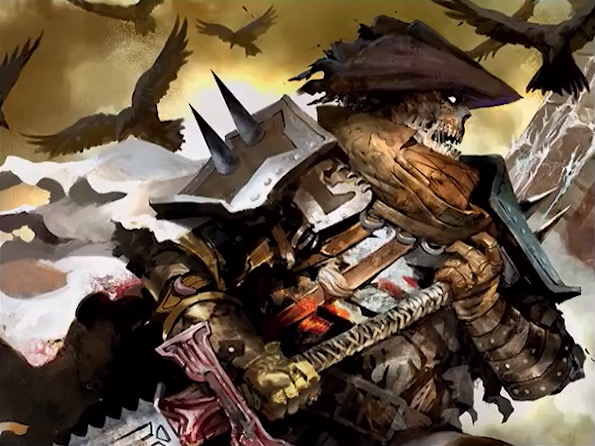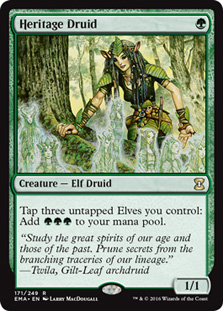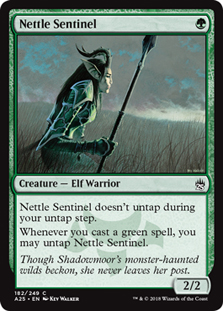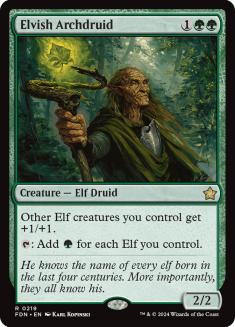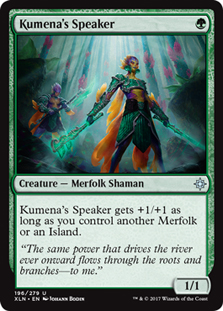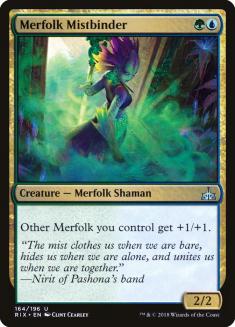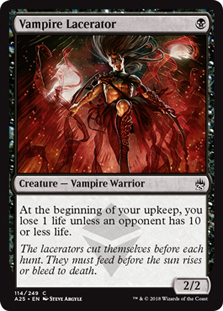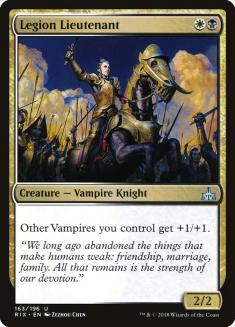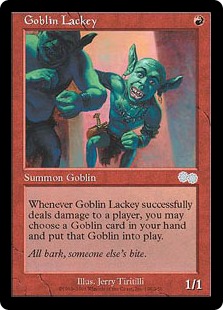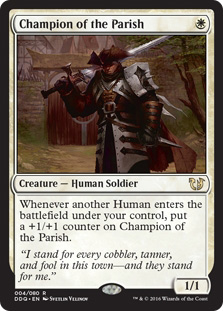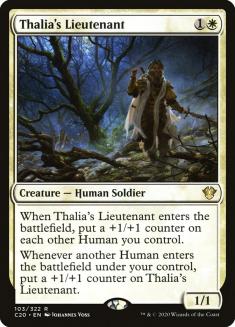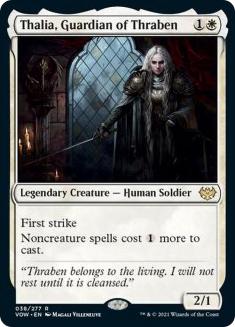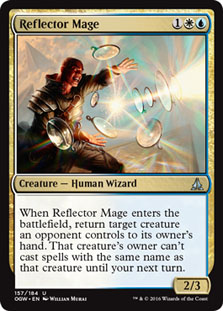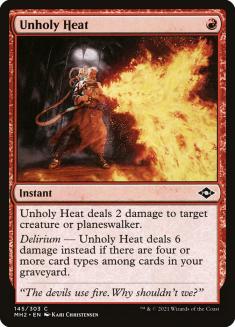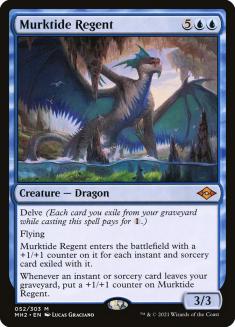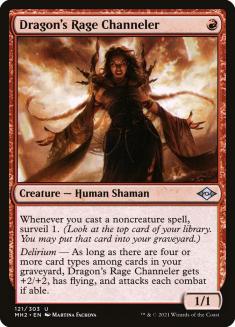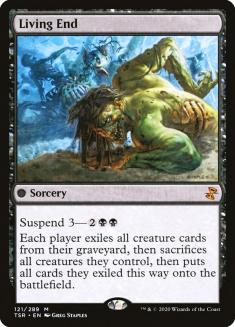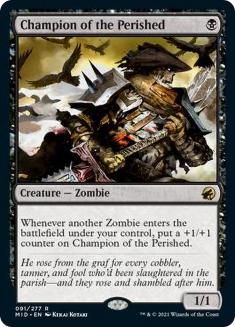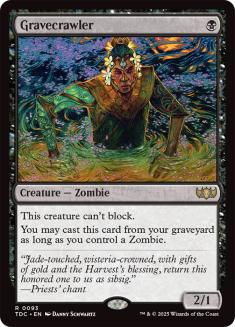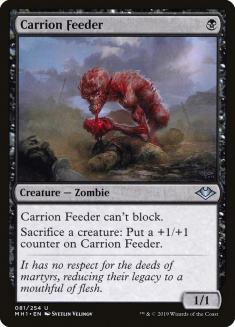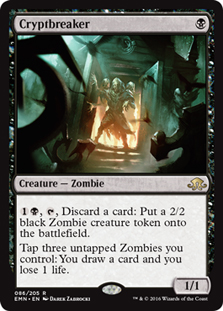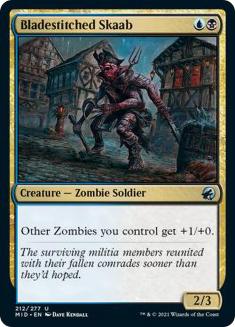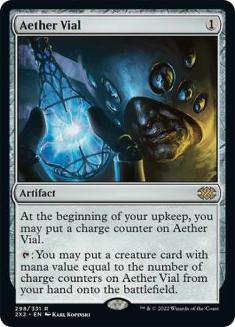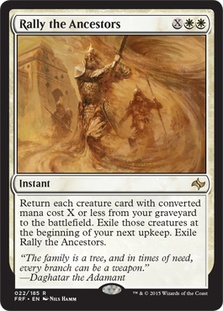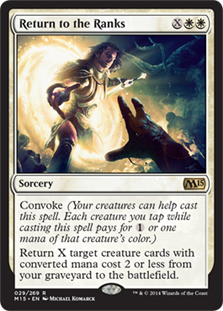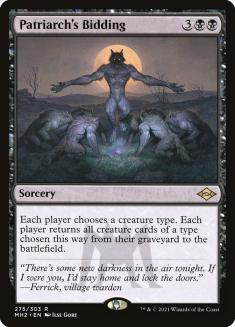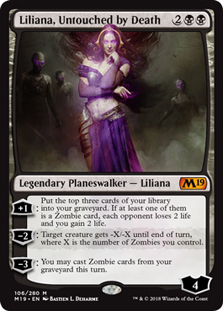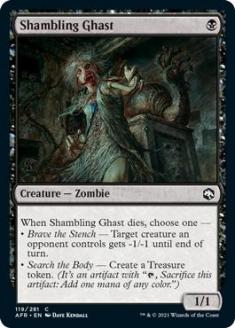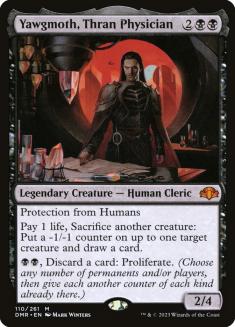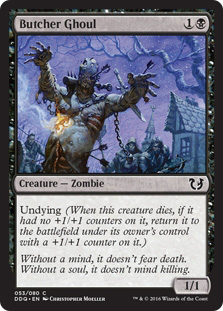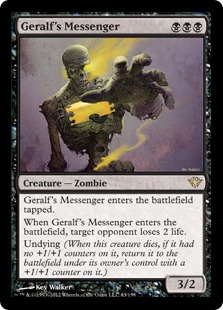Can you come back from the dead if you were never alive?
Magic’s slowest and most gormless tribe has never made waves in Modern. That’s not a cause for shame; tribal decks in general have struggled to compete. Iconic tribes like Elves and Goblins are marginal players now — if they were ever anything more. Merfolk are beloved by their fans but a running joke to their detractors. Elementals is a new contender but more of a Modern Horizons 2 tribal deck (with a cameo by Omnath, Locus of Creation) than anything else. You can’t play Plague Engineer in your Lurrus of the Dream-Den deck, but why would you even bother?
There are exceptions. Humans was the best deck for a long stretch and a fine one for much longer. Spirits took Modern by storm for a summer. Why did these decks succeed, however briefly? And why are they too struggling now?
Tribal decks as a class face a tradeoff between speed and versatility. At one extreme we find Elves — no other tribe, and almost no other deck, creates a dominating battlefield presence as swiftly as Elves. This has to be Elves’ unique selling point because it can’t really do anything else; the deck needs a very high density of tribal cards to do its thing reliably. Those cards all rely on each other, making the deck highly susceptible to the cheap removal that’s everywhere in Modern these days.
The result is a deck that has to be solely dedicated to one goal and can’t even use the few slots it has left over to good effect — your base-green creature deck can’t support the cheap interaction that’s so good against it from the other side. It’s easy to end up in the awkward pincer of being too slow to race the fast linear decks and not resilient enough to fight through a pile of removal spells.
Other tribes offer a similar cautionary tale that’s more widely applicable. I was finally ready to take Merfolk seriously when a new school showed up in Ixalan with the hard-hitting one-drop the deck was missing and yet more tribal payoffs higher up the curve. These additions did make the deck better at applying pressure, but it turned out that was never the problem. The incentives to play or avoid Merfolk were still its noncreature disruption. Merfolk is good when Force of Negation and Chalice of the Void are or when Spreading Seas is near its ceiling as a cantrip Sinkhole + Falter.
Every marginal tribe in Modern has an ideal curve of two-power one-drop into their own Lord of Atlantis and that’s never good enough. I’m prepared for Sorin, Imperious Bloodlord to break into Modern with Innistrad: Crimson Vow but it will take more than just another two-drop that pumps Vampires to move the needle there.
At the other extreme we find another iconic tribe that missed the mark in Modern despite an influx of new tools in the original Modern Horizons. Goblins has a ‘utility Goblin’ for every situation and several Goblin-exclusive combos as well as card advantage and direct tutors stapled to creatures to tie the room together, but it lacks the cheap creatures to enable its early development. I’m not holding my breath for Goblin Lackey, but something to join Skirk Prospector is necessary for the tribe to succeed. Many lists of Goblins had to run Aether Vial, not because the deck’s curve was ideal for it — quite the opposite — but because there simply wasn’t anything else to do on Turn 1.
Five-Color Humans won a place at the top table in Modern by meeting all of these requirements — a fine curve, a fast clock, and disruption attached to creatures avoiding the problem of having disruption without pressure or vice versa. This recipe was more potent when there were actual combo decks to be shut down by Meddling Mage and friends, but it should be a template for success at most points in Modern’s history. What changed?
Part of the problem is that the ‘normal’ decks just get to do it better. With the straight-to-Modern releases, the format is experiencing the same compression that Legacy went through a decade ago with its first visit to Innistrad. Pure aggro was squeezed out as the blue tempo shells now enjoyed the best threats as well as the best removal and card smoothing. Why bother trying to assemble the right crew of Humans when Dragon’s Rage Channeler is a self-contained threat and engine card that’s cheaper and bigger than any of them? A Turn 1 Champion of the Parish could quickly outsize a later Lightning Bolt or most blockers. Now it gets shot down by Unholy Heat or embarrassed by Murktide Regent.
To make matters worse, the format at large is broadly hostile to creatures that need to survive to accomplish anything. Playing against Fury once is enough to send any Humans or Elves enthusiasts into retirement.
This isn’t an encouraging backdrop for any new tribal strategy. What does Zombies have going for it?
Zombies has the most good one-drops of any tribe. Champion of the Perished, Gravecrawler, Carrion Feeder, and Cryptbreaker get you to sixteen, which is more than even the most focused hyper-aggressive decks in other formats that aren’t bound by tribal obligations. If you have enough graveyard or sacrifice synergies to take an interest in Stitcher’s Supplier, Shambling Ghast, or Nested Shambler, you can inflate that count even further. Note that this doesn’t even include Diregraf Ghoul or the next tier of recursive 2/1 Zombies like Dread Wanderer.
This high density of one-drops lets you get the most mileage from each of them. Turn 1 Champion of the Perished into two one-drops on Turn 2 is a realistic nut draw that usually amounts to a Turn 4 kill; any combination of three one-drops involving Cryptbreaker lets you start drawing cards on Turn 2. With a curve this low, you rarely have to waste mana and can find a window to cast a dead Gravecrawler or black’s premium interaction in Thoughtseize or Fatal Push.
All this means Zombies’ generic two-drop Lord does more work here. Bladestitched Skaab lets you mirror the Humans curve of Champion of the Parish into Thalia’s Lieutenant curve but is also an excellent Turn 3 follow-up to a trio of one-drops.
Zombies doesn’t get to attach Thoughtseize or Fatal Push to a rotting corpse for the true Humans parallel, but it enjoys the best noncreature versions of these effects, which are necessary for an otherwise one-dimensional deck to compete.
Gravecrawler’s refusal to stay dead is crucial here. A tribal deck that just presents a single-file procession of flimsy threats is inherently weak to removal no matter how strong these threats are. Gravecrawler lets each new Zombie bring back an additional body, which in turn can be converted into other resources via Carrion Feeder or Undead Augur. It indirectly supports your interaction too by making sure you have a threat that sticks around to narrow the window the opponent has to recover from disruption.
Any deck with this many creatures has to consider Aether Vial and the uniquely lean curve of Zombies presents an original problem. If you have so many one-drops that you can safely keep Aether Vial there, you aren’t getting a compelling discount on your spells and will often be able to just cast that one-drop instead. Perhaps you have other good uses for your mana — activating Cryptbreaker, recasting Gravecrawler, or unloading a hand full of cards from Undead Augur — but a curve clustered at the bottom doesn’t use Aether Vial to its full potential.
Any deck with, well, white or black mana has to consider Lurrus. There are appealing curve-toppers at three mana — most notably Geralf’s Messenger — but if these are your only cards incompatible with Lurrus, it’s hard to justify choosing them instead. Champion of the Perished and Carrion Feeder are one-drops for Lurrus to recast immediately that can quickly balloon out of control, forcing the opponent to have removal for that creature as well as Lurrus itself.
A bare-bones beatdown list would look something like this, with more copies of Dark Salvation or Inquisition of Kozilek replacing Geralf’s Messenger if you opt for Lurrus.
Creatures (28)
- 4 Carrion Feeder
- 4 Gravecrawler
- 4 Geralf's Messenger
- 4 Cryptbreaker
- 4 Undead Augur
- 4 Champion of the Perished
- 4 Bladestitched Skaab
Lands (22)
Spells (10)

As much as I’d love for this to be good, I doubt it can clear the high bar described earlier. Why not set a different goal?
Creatures (32)
- 4 Carrion Feeder
- 4 Gravecrawler
- 4 Cryptbreaker
- 4 Wayward Servant
- 4 Stitcher's Supplier
- 4 Undead Augur
- 4 Shambling Ghast
- 4 Champion of the Perished
Lands (21)
Spells (7)

The Zombie Rally shell that Ari revisited for Pioneer is an easy port to Modern, where Carrion Feeder is a critical upgrade to Nantuko Husk enabling fast kills and allowing Lurrus. With 24 one-drops in this list, Rally for X = 1 generates a substantial battlefield presence with a permanent boost to Champion of the Perished and Carrion Feeder and a giant stack of triggers from Wayward Servant (and Undead Augur with a sacrifice outlet). Shambling Ghast creating a Treasure on its way out allows a Rally to partially pay for itself — with several Ghasts making Rally ‘free,’ you can churn through your deck with Carrion Feeder and Undead Augur to keep the chain going and win in that turn cycle (if necessary, by discarding any drawn Wayward Servants during your cleanup step and then firing off another Rally on the opponent’s upkeep).
Return to the Ranks is a backup Rally that pays for itself more easily with white Zombies like Wayward Servant, Tidehollow Sculler, or Corpse Knight helping with convoke. It’s a shame that an old favourite like Patriarch’s Bidding is smuggled into Modern just to be obsoleted even in the tribal combo deck, but at least the patriarchy is taking a loss somewhere…
Creatures (27)
- 4 Carrion Feeder
- 4 Gravecrawler
- 4 Cryptbreaker
- 3 Stitcher's Supplier
- 4 Undead Augur
- 4 Shambling Ghast
- 4 Champion of the Perished
Planeswalkers (4)
Lands (21)
Spells (8)

A more deterministic combo involves Liliana, Untouched by Death and Shambling Ghast with a sacrifice outlet — once again, Carrion Feeder is a vital gift from the first Modern Horizons. Liliana’s [-3] ability extends throughout your turn and includes Zombies that aren’t in the graveyard yet, letting you recast the same Shambling Ghast endlessly (creating a Treasure and then using it to pay for the next Ghast) and rack up Carrion Feeder or Goblin Bombardment activations. This package doesn’t require cards you’re unhappy to play outside the combo and Liliana itself is an excellent payoff pre-combo, rebuilding your battlefield from nothing, digging for missing combo pieces, or removing a creature in an emergency.
These decks illustrate just how strong Goblin Bombardment is with the right support. Gravecrawler letting you spend a black mana to shoot something can lock creature decks out of the game easily without any convoluted infinite combo and gives you a form of reach that the dedicated aggro version above can only envy.
Finally, I think Ari was onto something with another of his sketches:
Creatures (30)
- 4 Carrion Feeder
- 4 Gravecrawler
- 4 Geralf's Messenger
- 4 Butcher Ghoul
- 1 Relentless Dead
- 4 Undead Augur
- 4 Yawgmoth, Thran Physician
- 1 Shambling Ghast
- 4 Champion of the Perished
Lands (22)
Spells (8)

I’ve been searching for other homes for Yawgmoth, Thran Physician and a deck that leans into Goblin Bombardment is an ideal candidate. Geralf’s Messenger is already in the mix and from there it’s a short step to Butcher Ghoul, which also pairs well with Bombardment and Carrion Feeder. The undying loops with Yawgmoth give the deck a distinct end-game to build towards and a more diversified mana curve makes Aether Vial worthwhile even without the Imperial Recruiter chains Ari was exploring.
Champion of the Perished may look like an obvious riff on a familiar aggro card but it brings a lot more design space. I don’t know how strong any of these shells will be, or how they ever beat a Sanctifier en-Vec, but I do know I’m keen to raise the dead as soon as I can.

